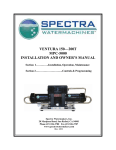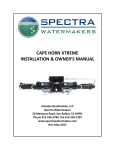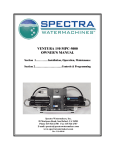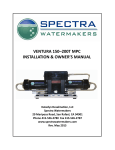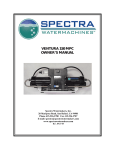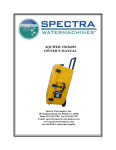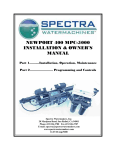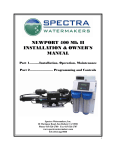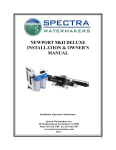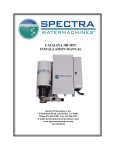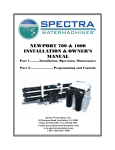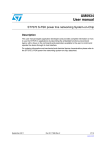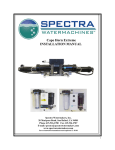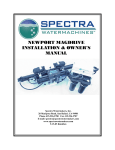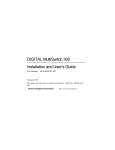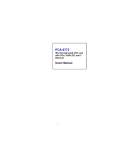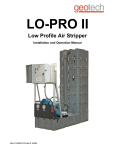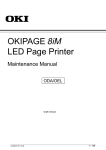Download ventura 150 - 200t deluxe installation & owner`s manual
Transcript
VENTURA 150 - 200T DELUXE INSTALLATION & OWNER’S MANUAL Spectra Watermakers, Inc. 20 Mariposa Road, San Rafael, CA 94901 Phone 415-526-2780 Fax 415-526-2787 www.spectrawatermakers.com Rev 12/11 2 Table of Contents Page Number Installation Getting Started .....................................................................................................................4 Suggested Spares .................................................................................................................5 Introduction ..........................................................................................................................6 Plumbing Layout ..................................................................................................................7 Installation Basics ..............................................................................................................10 Wiring Diagram .................................................................................................................11 Membrane Pressure Vessel Relocation ..............................................................................31 Feed Pump Relocation .......................................................................................................33 Z Brane ..............................................................................................................................34 Operation New Systems Start Up Procedure ......................................................................................12 Dry Testing with an Artificial Ocean.................................................................................13 Normal Operation and Fresh Water Flush .........................................................................14 Service & Maintenance Long Term Storage ............................................................................................................15 Storage Procedures.............................................................................................................17 Anti-Freeze and Winterizing ..............................................................................................18 Maintenance .......................................................................................................................19 Flow Test ...........................................................................................................................21 Cleaning Chemicals ...........................................................................................................22 Membrane Cleaning Procedure ..........................................................................................23 Trouble Shooting ..............................................................................................................24 Technical Bulletins: Flow Meter Service............................................................................................................25 Pre-Filters...........................................................................................................................26 Charcoal Filters..................................................................................................................27 Accumulator Pressure ........................................................................................................28 Feed Pump Won’t Run .......................................................................................................29 Feed Pump Cuts Out ..........................................................................................................30 Parts Identification ...........................................................................................................38 3 Getting Started Unpack the system and inspect it to make sure it was not damaged during shipping. Refer to the shipping list for your system. Make sure you received all of the components listed. Do not discard any packaging until you have found and identified all of the parts. The small installation parts are listed on the kit list. Warning! We will not be held responsible for shortages and or freight damage that are not reported within thirty days of the ship date. Study the system layout diagram, component photos, and descriptions before beginning installation. Layout the system. Before starting the installation identify where each module and component will be placed. Insure that there is enough clearance around the components for removal of filters and system service. Make sure you have adequate tubing and hose before starting. Additional parts may be ordered. THE VENTURA 200T IS DESIGNED FOR WARM WATER USE ONLY. DO NOT OPERATE IN WATERS BELOW 500 F (10 0 C) Ventura Deluxe Shipping List High Pressure Clark Pump and Reverse Osmosis Membrane Module. Inlet Feed Pump Module with Fresh Water Flush System. Accumulator Tank Manual Analog Gauge Assembly Installation Fittings Kit 5/8” Hose (25’) Service Kit 4 Suggested Spares Short term cruising, weekends etc. We suggest a basic Cruise Kit A. This kit consists of six 5 micron filters and SC-1 storage chemical. Cruising 2 to 6 months at a time. Two basic cruise kits, one replacement charcoal filter, one replacement feed pump head. Longer than 6 months Additional filters, Offshore Cruising Kit consisting of Clark Pump seals, O-rings, tools, and membrane cleaning chemicals. One replacement strainer screen, O -ring for strainer screen, O-rings for filter housings. Spectra Watermakers parts list: Part Number SC-1 STORAGE CHEMICAL SC-2 CLEANER SC-3 CLEANER BASIC CRUISE A 5 MIC FILTER CHARCOAL FILTER 5” STRAINER SCREEN OIL/WATER FILTER FEED PUMP HEAD 5” STRAINER O-RING FILTER HOUSING O -RING OFF SHORE KIT 20” MEMBRANE CHARCOAL FILTER O -RING KIT-CHEM-SC1 KIT-CHEM-SC2 KIT-CHEM-SC3 KIT-BCK-A FT-FTC-5 FT-FTC-CC FT-STN-5S FT-FTC-OW PL -PMP-SFPH SO-STN-5SS SO-FHS-10H KIT-OFFSH FT-MB-20 SO-FHS-3PCS10 5 Introduction to the Ventura Deluxe The Ventura is the finest watermaker for small and midsized yachts available. Properly installed and maintained it will supply years of reliable service. Prudent operation is required with any marine equipment. Always maintain enough reserve water to get safely into your next port. The Spectra Intensifier, known as the Clark Pump, was introduced in 1997 and has continually improved since. It is built of modern non -corrosive composites and comes with a 21” high rejection membrane. Front View Pressure Relief Valve Quick disconnect fitting to facilitate maintenance. Double rubber mounts for to absorb vibration Fresh Water Flush Valve Cooling Fan Motor Service Port Rear View Service Valve Shurflo Pump The Clark Pump Membrane Module. Pre mounted and plumbed together as a single unit. Saves time and adds reliability. Ventura Feed Pump Module. Includes the feed pump, cooling fan, charcoal filter for the flushing system, flush valve, service valve, and service port The module has compact and streamlined plumbing, the cooling fan is included for longevity. 6 Ventura Deluxe Plumbing Brine Discharge (Not Included) thru hull: place above waterline or tee brine into another visible drain. Pressure Relief Valve Spectra Clark Pump. Mount in a cool location. May be oriented in any position and can be well above waterline. Leave access to the pressure relief valve. Do not mount over electrical equipment. Use supplied spacers and washers for the vibration mounts. Plastic fittings should have 3-4 wraps of Teflon tape and will screw almost all the way in. Leave the bottom pipe thread un-taped. Avoid getting dirt or debris in the system during assembly. Avoid tight bends and elbows. Secure piping away from moving objects and protect from chafing. Fresh Water Flush inlet to charcoal filter. Plumb to the pressurized side fresh water system. Accumulator, Factory precharged. 5 micron filter. Do not mount over electrical equipment. Leave clearance below for filter change. Sea Strainer, Mount with Quick Block Feed Pump Module. Mount vertically as low as practical, no more than 3’ (1 M) above waterline and not over electrical equipment. Leave clearance below for filter change. 1/2” or 3/4 scoop strainer thru hull and Seacock. Mount low, in a clear flow and away from head discharge. Thru hull is shipyard supplied. 7 Product Water and Pressure Gauge Tube Installation Route the product water from the valve into the top of the tank. Install a tee in the water fill or tap a pipe thread into an inspection port. Sampling Tap for testing the product water and service procedures. Put enough tube on this port to reach your service container. Product to tank. DO NOT! feed the product into a vent line, manifold, or the bottom of the tank. Make sure that there is no restriction in this piping. Pressure in the product tubing must never exceed 5psi (.3bar) at any time, (running or stopped) or the membrane will be permanently damaged. Product sampling valve. Mount using the supplied plastic straps as shown. Note: the handle is pointing in the direction of the flow. Pressure Gauge Use accumulator port to connect the pressure gauge. Use the supplied 1/4” black nylon tubing. Tubing must be pressure rated to 150 PSI (10 BAR) Product Flow Meter Plastic fittings should have 3-4 wraps of Teflon tape and will screw almost all the way in. Leave the bottom pipe thread un-taped. Avoid getting dirt or debris in the system during assembly. Secure piping away from moving objects and protect from chafe. Exercise care not to cross thread the fittings. See the tube assembly instructions next page. Back view of instrument panel. Use the supplied 1/4” black nylon tubing for the product plumbing Product Ports are located here Remove one of the product port plugs (from either end) and screw in the product fitting. Must be Teflon taped. Product fitting 8 Spacer O-ring Grab Ring Body Nut Tubing Step 1: Dissemble fitting components 1/2" max Step 2: Install the Nut first then use the bevelled side of the Spacer to push the Grab Ring onto the tube no more than 1/2". Slip the O-ring over the tube to hold the Spacer in place. If the Grab Ring is pushed too far, trim back the tube so about 1/4" of tube extends past the O-ring. Step 3: Gently fit the tube into the body and loosely thread on the nut. Step 4: Push the tube into the body until it bottoms out then hand tighten the nut. DO NOT OVER TIGHTEN! 1/4" Tube Fitting Assembly 9 Installation Basics Thru-hull Not Supplied. Read the directions! Avoid tight hose bends hoses and excessive runs. Use heavy gauge wire. Install Feed Pump Module as low as possible. Use a dedicated thru hull with scoop type strainer Seawater Flow Thru-hull Location It is mandatory that a dedicated 1/2” to 3/4” forward facing scoop type intake thru -hull and seacock be installed. Install the thru -hull intake around the middle of the hull and as far below the water line as possible. Do not install the intake close to, or downstream of, a head discharge, or behind the keel, stabilizer fins, and other underwater fixtures. Install as far below the waterline and as close to center line as possible to avoid contamination and air induction. Thru-hulls in the bow area are susceptible to air intake in rough conditions. Sharing a thru -hull with another system is not acceptable and will void the warranty. Sharing a thru -hull can introduce unforeseen problems such as intermittent flow restriction, air bubbles, and contaminants. For racing boats and high speed boats traveling above 15 knots, a retractable snorkel -type thru hull fitting is preferred because it picks up water away from the hull. The brine discharge thru -hull should be mounted above the waterline, in or just above, the boot stripe to minimize water lift. Double clamp all hose connections below the waterline. Pipe Fitting Instruction Plastic to plastic fittings need 3 to 4 clockwise wraps of Teflon tape over their threads. Hold the fitting in your left hand and tightly wrap fitting threads clockwise. For smoother assembly, do not tape the bottom threads. Avoid getting dirt or debris into the piping or hoses during assembly. A small bit of debris can stop the system! Avoid restrictions or long runs on the entire Inlet side of the plumbing from the thru hull to the Feed Pump Module. Prevent tight bends and excessive elbows. Any restrictions will hamper system performance. Secure the piping away from moving objects such as engine belts and hatches. Prevent chafe on the tubing as required. Test and inspect all piping and hose clamps after several hours of operation. Wiring Pay attention to wire size or system performance will be impaired Perform wiring to UL, ABYC, CE or applicable standards 10 Ventura Deluxe Wiring Diagram Route a heavy pair of wires from the main DC electrical panel to the Feed Pump Module. Refer to wire guides below. Wire length is the sum of the length of the Positive and Negative wires. Example: 7 feet of wire is needed to connect the DC electrical panel to the Feed Pump Module. In order to figure out what type of wire you need: 7 + 7 = 14. Since 14 is less then 15 you would use: #10 Gauge (6mm) to 15 feet (4.5 M). Connect wires using supplied terminal block, then seal connectors. A switch located near the Feed Pump will facilitate maintenance. Voltage drop will impair performance of the system. Wire Size Guide for 12 VDC Ventura Deluxe Protect with 15 Amp Fuse or Circuit Breaker # 10 Gauge (6mm) to 15 feet (4.5M) # 8 Gauge (10 mm) to 25 feet (7.5M) #6 Gauge (16mm) to 35 feet (10.6M) Wire Size Guide for the 24 VDC Ventura Deluxe Protect with 7 Amp Fuse or Circuit Breaker #12 Gauge(4mm) to 10 feet (3M) #10 Gauge (6mm) to 25 feet (7.6M) Feed Pump wiring: #8 Gauge (10mm) to 35 feet (10.6M) Red is Positive Black is Ground. Main DC Electrical Panel Cooling Fan Connects in parallel with the feed pump. Pre -wired at the factory. DC negative buss bar To Battery 11 Ventura Deluxe New System Startup Avoid running the Ventura Watermaker if the vessel is in contaminated water, such as in a polluted harbor or canal. The system should be fully run tested before you leave port. If the location or weather prevents proper testing refer to the manual section, “Dry Testing.” Warning! Damage may occur if the purge sequence is bypassed and the membrane is pressurized with storage chemical in it, or if the sea temperature is too low (200T only). 1. First check that: Thru-hull Inlet Valve is open and the Brine Discharge Valve is open. All of your hose connections are tight. The green “WARNING” tag and spacer from under the pressure relief valve has been removed. The pressure relief valve is open 1/2 turn. The Sampling Valve is set to the sample position. Remove Tag and Washer! Sample Valve To Tanks Open 1/2 Turn to Purge Chemicals! 2. Turn on the feed pump. Check to make sure water is coming out of the brine discharge valve, (thru-hull above water). 3. Run the system with relief valve open for 20 minutes to purge the storage chemicals. The flow pressure gauge should read around 20 PSI (1.2 bar). This is open flow pressure since the pressure relief valve is open. 4. Close the pressure relief valve. The pressure should rise to 60—90 PSI (4.2-6.2 bar). After several minutes, water should begin to flow out of the sampling tube. If the vessel is located in brackish or fresh water the pressure will be lower. 5. Allow the system to run for 10 minutes then test the product with your hand held Salinity Tester. When the product is below 750 PPM it is considered potable and can be diverted to the tank. Turn the Sample Valve to divert product into your tanks. 12 Dry Testing With Artificial Ocean If it is not possible to test run the system with the boat in the water, testing may be accomplished with an artificial ocean. Purchase enough aquarium salt to make 5 gallons (20 liters) of saltwater. Standard saltwater ocean salinity is 32 mg of salt per liter of water. Make sure the domestic water system is powered up and the boat’s tank has at least 30 gallons (120 Liters) of water. Confirm that the charcoal filter is installed in the Feed Pump Module, and the domestic water line had been installed. 1. 2. 3. 4. Open pressure relief valve on the Clark Pump. Remove the green tag and spacer! Turn the yellow service valve on Feed Pump Module to OFF. Open the grey flush valve on the charcoal filter housing. (Feed Pump Mod.) Start the feed pump (Flip metal toggle switch located on the top right corner of Feed Pump Module to ON). Let feed pump run for manually for 20 minutes to purge the storage chemical. 5. Stop the feed pump, (Metal toggle to OFF). 6. Hook up your Inlet service hose to the service port on Feed Pump Module. Then hook the Brine Discharge service hose to the quick disconnect on Clark Pump. Refer to the photo below. Route hoses into the 5 gallon (20 Liter) container. Turn product sample valve to the sample position. Route the product output into a bucket. 7. Open the grey flush valve and turn on the feed pump. Fill the container with fresh waProduct Sample Valve ter. Stop the pump and close the grey flush valve. 8. Turn the yellow service on the feed pump module valve to SERVICE. 9. Mix the salt to the proper proportion or use an aquarium hydrometer to adjust the salinity level. Standard ocean salinity is 32 mg of salt per liter of water. 10. Start the feed pump, allow to prime, then close the pressure relief valve on the Clark Pump. The system should build pressure and after several minutes start making water. 12. Run the system under pressure and check for proper operation and leaks. After testing the system stop the feed pump. Remove Inlet service hose and replace the Brine Discharge hose. Turn yellow service valve to RUN. Perform a fresh water flush. A fresh water flush will hold the system for 4-5 days. If the system is to continue to be commissioned, performing a fresh water flush will hold the system for 4 -5 days. If you don’t intend to use the system in near future we recommend pickling the system following the storage procedure, explained in this manual. Flush Valve Open Service Valve Flush Valve Closed Service Valve to SERVICE Connecting the Brine Discharge service hose. Valves in flush position Valves in service position Inlet service hose connected. 13 Normal Operation and Fresh Water Flush If the system has been pickled or stored or contains cleaning compounds, use the “New System Startup” procedure. Product Sample Valve DO NOT OPERATE THE VENTURA 200T IN WATER BELOW 50 DEG F (10 DEG C) - DAMAGE WILL OCCUR. 1. 2. 3. 4. Check to see that the thru -hull inlet is open. Turn the product sample valve to the “sample” position. Turn yellow service valve on Feed Pump Mod to RUN. Analogue Gauge Start the feed pump (turn the metal toggle switch located on the feed pump Panel module to ON) and check for flow by inspecting the brine discharge or checking for pressure on your analog gauge. If there is no flow open the pressure relief valve on the Clark Pump and bleed the air out of the feed pump. 5. After 5 minutes check the product water with your hand held salinity tester. When it is below 750 ppm, divert product into your tank by rotating the Product Sample Valve handle 90 degrees. 6. Run the system until you have filled your tank or have made enough to meet your requirements. Fresh Water Flush 1. Turn the yellow service valve to OFF. Open the grey flush valve on filter housing (Feed Pump Mod). 2. Flush for 2 1/2 minutes. Pressure will drop on the gauge, this indicates that the membrane is flooded with fresh water. Stop the feed pump. 3. Return the yellow service valve to RUN. Close the grey flush valve. You may now leave the system unattended for up to five days without further attention We recommend operating the system for longer periods and effecting a fresh water flush rather than running the machine every day and not flushing the system. Remember that you need to run the system almost a half an hour to make enough flushing water. You may notice that the system output is higher while charging your batteries as the machine is voltage sensitive. Open Closed OFF RUN Inlet Module with valves in the “Run” Position. Inlet Module with valves in the “Flush” Position. 14 Long Term Storage Procedures Watermakers are best when run continuously. When not in use, biological growth in the membrane is the leading cause of membrane fouling. A warm environment will cause more growth than a cold environment. A Fresh Water Flush every five days will greatly reduce biological growth but may not stop it completely. You can also protect you watermaker with the optional Z-Brane water treatment system. Z -Brane systems protect the membrane from bio -fouling with out the use of storage chemicals. System Storage or “Pickling” If the system is to be left unused for more than five days, perform the following storage procedure. A system can be stored for up to six months with SC -1 Storage Compound. The procedure introduces a chemical into the system that prevents biological growth. This procedure requires de-chlorinated water which can be made with the charcoal filter. Charcoal filters last a maximum of 6 months once wetted. Spectra SC-1 a special storage compound used by the US Navy. It is formulated to be compatible with the modern engineering plastics and composites in the Spectra pumps. Do not use any other substances except propylene glycol for storage. If you wish to use glycol for storage, follow the ‘Winterizing Instructions’. SC-1 Storage Compound has to be mixed at a ratio of 1 container to 3 gallons (12L) of fresh water to have the proper solution for short term storage. Remember there is at least two gallons of water resting inside your watermaker at all times. Caution! Avoid contact with skin, eyes, or lungs with the storage chemical. 15 OP-3 STORAGE CHEMICALS 101 Spectra Systems use four types of chemicals: SC-1, SC-2, SC-3, and propylene glycol antifreeze . NOTE: Never use any chemicals with the system pressurized! Always open the pressure relief valve on the Clark Pump 1/2 turn. Always purge a system containing chemicals for at least 20 minutes unpressurized before pressurizing (closing the pressure relief valve) and making water. The SC-1 is for storage only. See “Storage Procedure” in manual. This chemical and procedure allows you to store your watermaker for up to six months. 1. Perform a Fresh Water Flush until the brine discharge is below 1000 ppm or does not taste salty. Mix one jar of SC -1 with one gallon of product or dechlorinated fresh water in a bucket and circulate UNPRESSU RIZED for 10 minutes , then discard. The system shoul d be repickled every six months. Propylene Glycol: See “Winterizing” for instructions on this procedure The Spectra systems should be stored with propylene glycol if freezing could occur. This is the food grade antifreeze used to winterize RV s, boats and cabins. This also works very well for storing in warm clim ates and is good for one year. NOTE: Do not use metasodium-bisulfate, the standard chemical used to store most watermakers. This chemical will permanently damage the Clark Pump and void the warranty. 16 Service Port Storage Procedure The watermaker has two gallons of water in the system at all times. Take this into consideration, make sure chemical is applied in Flush Valve Open proper concentration. Service Valve OFF 1. Perform a Fresh Water Flush as described in the “Normal Operation” section. Turn off the feed pump and close the grey fresh water flush valve. Leave the yellow service pointed towards OFF. 2. Remove the quick disconnect fitting from the Brine Discharge outlet of the Clark Pump, and replace with the Brine Discharge Service hose Lead the hose to a 5 gallon bucket or container. Valves in flush position 3. Perform another fresh water flush. Open the grey fresh water flush valve. Run the feed pump until you have one gallon of fresh water in the bucket. Turn off the feed pump and close the grey fresh water flush valve. 4. Mix 1 container of SC -1 storage compound with the water in the bucket. Some of the storage chemical may not dissolve completely, this is considered normal. 5. Connect the service hose to the service port Feed Pump Module. Use the garden hose barb fitting from your service kit. Lead the hose into the bucket. Turn the yellow service valve on the Feed Pump Module to SERVICE. Intake is now coming from the bucket. 6. Make sure the pressure relief valve on the Clark pump is Open (unpressurized). 1/2 turn counterclockwise. 7. Turn on feed pump (metal toggle switch on top right corner of Feed Pump Module). Circulate the storage chemical in the system for approximately 10 minutes. Turn off feed pump when finished. Clean Up: Remove the quick disconnect from the Clark Pump brine discharge, and replace the original hose that leads to the thru -hull. Turn the yellow service valve back to RUN, and remove the service hose. Close the seacock, drain, then clean the sea strainer and pre -filters. Reassemble dry. 17 Winterizing with Antifreeze The watermaker can be stored for up to one year in using this procedure. 1. Fresh water flush the watermaker. (Refer to “Normal Operation,” Fresh Water Flush.) Turn off feed pump (metal toggle switch in top right corner of Feed Pump Module). Close grey flush valve (located on Feed Pump Module). 2. Connect the Inlet service hose to the service intake on the Feed Pump Module, and lead to service bucket. 3. Turn the yellow service valve to the SERVICE position. 4. Pour 2 gallon (8L) of propylene glycol in the bucket. 5. Make sure that the pressure relief valve on the Clark Pump is OPEN a 1/2 turn. (System must be un-pressurized). 6. Turn on feed pump until antifreeze begins to show out of the brine overboard thru -hull, then stop the pump. Add more antifreeze if necessary. 7. Connect the brine discharge service hose to the quick disconnect on the side of the Clark Pump and lead it to the service bucket. 8. Circulate the antifreeze for about 10 minutes. 9. Stop the feed pump. Reconnect the brine discharge hose that leads to thru -hull. Run the feed pump until the bucket is empty. 10. Close the seawater intake. Turn yellow service valve to OFF. Drain the seawater strainer and the hose leading to the Feed Pump Module. Disconnect the product tubing from the membrane housing and blow residual water out of the tubing with compressed air. Empty the charcoal filter housing and flush water lines. Open the pressure relief valve on Clark Feed Pump Module Valves in flush position Flush Valve, Open Service Valve, OFF Connecting brine discharge hose Valves in service position Flush Valve, Closed Service Intake Service Valve, SERVICE 18 Maintenance General Periodically inspect the entire system for leakage and chafing. Repair any leaks you find as soon as practical. Some crystal formation around the Clark Pump blocks is normal. Wipe down any salt encrusted areas with a damp cloth. The Seawater Strainer The seawater strainer’s stainless steel element should be inspected, removed, and cleaned as needed. Be careful to ensure that the thru -hull is closed before disassembly and the gasket is in place before reassembly. When the system is put into storage, remove, rinse with fresh water, and reassemble dry to impede corrosion. Check frequently during operation. The Prefilter Service the prefilter on a regular basis. The pressure will rise on the remote gauge when the filter becomes dirty. Extremely dirty filters will harm system performance and may cause the feed pump to cycle on the high pressure switch. Leaving dirty filters in the machine during long idle periods will cause biological contamination. To service the filters: Turn yellow service valve on Feed Pump Module to OFF, open the housing, and discard the old filter. Clean out the housing bowl, reassemble the housing with a new 5 micron filter element. Leave dry until next startup. Use only Spectra approved filters or you may void your warranty. The filters may be cleaned up to three times with a soft brush and water in a bucket. Occasionally, lightly lube the filter housing O -ring with silicone grease. Oil Water Separator (Optional) For oil water separation capability, install the additional filter housing with its oil removal filter upstream of the 5 micron filter. Service at the same time as the 5 micron filter. The Charcoal Fresh Water Flush Filter Replace the charcoal filter element at least every 6 months! This filter protects the membrane by removing chlorine from the flush water. Use only a Spectra replacement! The Feed Pump and Clark Pump The feed water pump and the Clark Pump require no routine maintenance except inspection for leaks. Tighten any hose clamps or fittings that show signs of leakage. The high pressure fittings threaded into the Clark Pump have O -ring seals with a straight thread. These should never leak and should never be over tightened. If one of the tube nuts starts to leak, it can be un -threaded, sealed with a bit of silicone grease or oil, and tightened with two wrenches very tightly. 19 Maintenance Continued... The Membranes Always perform a flow test before cleaning your membrane. Cleaning shortens the lifespan of membranes, so only clean after you have investigated all other potential causes. The leading cause of fouling is from biological growth that occurs when the system is left unused without flushing or pickling. Fouling from mineral scaling can happen during operation under certain seawater conditions and from rust. Monitor the product salinity and feed pressure for higher than normal readings, take environmental conditions into consideration. Cold feed water or clogged filters can cause high pressure. Low product flow is usually due to low voltage, or a worn Feed Pump / Clark Pump. Look for all other causes before cleaning the membrane. Membrane life can be shortened by excessive cleaning. Cleaning Compounds There are two types of cleaners: acid and alkaline. The acid cleaner (SC-3) will remove mineral scaling and is generally used first. The alkaline cleaner (SC-2) is used to remove biological by-products, oil, and dirt particles that get past the prefilters. If membrane performance is reduced and the system has not been pickled recently, cleaning with both chemicals is recommended. The acid cleaner should be used first. If the membrane fails to respond to both cleanings, this is an indication of another problem with the system, or that it is time to replace the membrane. Contact Spectra Watermakers before removing a membrane. If known bio-fouling is present, the SC-2 may be used first. If the history of the system is unknown or has been left “unpickled” for an extended length of time and biological growth is present, consider cleaning with SC-2. Use unchlorinated fresh water and do not pressurize the system (leave the pressure relief valve open when cleaning). De-chlorinated fresh water can be obtained by running water through your Spectra charcoal filter. Test to see if biological growth has occurred. Before running the system, remove the prefilters and examine their condition. If the filter housings are full of smelly discolored water, the system was not properly stored. Install clean prefilters. Next check the membrane. Detach the brine discharge hose and lead to a bucket. Open the pressure relief valve one turn, and manually run the system for 30 seconds (metal toggle switch on Feed Pump Module). Examine the brine water: if it is discolored and smells bad, perform an SC 2 cleaning with de-chlorinated water before running the system pressurized. If the brine is fairly clean, follow the “new start up procedure” and run normally. Check for performance. Clean the membranes only if performance is reduced. Warm water is ideal for cleaning membranes. One way to do this is to find a camp stove and use a large stainless steel pot to heat the solution to 120° F (48 C), you might have to periodically stop and reheat the solution. Perform the cleaning procedures while the vessel is in acceptable sea water for purging and testing . 20 Perform a FLOW TEST before you clean your membrane. The change in production is normally caused by something other then the membrane unless the system has been left unused for long periods of time. Excessive cleaning can damage your membrane. HS LF-2 FLOW TEST/ SHURFLO Before the test, change all filters and clean the strainer. Make sure that there are no leaks. Check for air leaks, as air in the system will cause low production and erratic salinity. Look for air bubbles in the product flow meter, feed water hoses, and brine overboard hose. Run the system and watch the pressures very closely. Make sure that each shift of the Clark Pump is even from side to side. If the feed pressure or time between shifts of the Clark Pump is different (asymmetrical) from one stroke to the other, this could be part of the problem. A difference of a few PSI is acceptable, but anything over that is an issue. If the pump is asymmetrical, Clark Pump repairs should be done before continuing with these tests. Ask for “ CP-5 Clark Pump Checkout ” instructions. If no asymmetry is noted, continue with this test. NOTE: On 150 and 200 models with only one feed pump, disregard the instructions concerning “Pump Two” and “Both” Make sure the ShurFlo overpressure cutout switches (p/n PL -PMP-SFPH), are set to 125 psi. With pump 1 running, close the brine service valve. The feed pressure should rise to 125 psi and the pump should shut off. If the pumps shut off at a lower pressure see “ SF-2 Adjust ShurFlo Pressure Switch” bulletin. 1. Measure and log the product flow (Gallons Per Minute or LPM) and the feed pressure with pump running. Use a graduated container and timer to measure the flow. Log the voltage at the feed pump at the same time. Confirm at least 12.5 volts DC (25 VDC for 24 volt systems) at the pump. You may have to run the engine or battery charger during the test. 2. Measure the total flow rate of the system. Run the system making water and divert the brine discharge and the product water into a bucket. Time how long it takes to make a given amount of water. Determine each flow rate independently, and add them together for total flow. In order to make good water, you need the proper amount of feed water flow. The pump should produce 1.5 gallons per minute (5.7 lpm). Compare the product flow to the total feed flow. Product flow should be 7% of total flow for a 150, and 10% on a 200T. If product percentage is low, you may have an internal leak in the Clark Pump. For every 1/10th of a gpm feed water flow loss, there is about 1/2 gallon per hour of product flow lost and the salinity will go up 100ppm. Low feed flow combined with low system pressures (see Misc-4: Nominal Pressures) is most frequently due to worn ShurFlo pump heads (p/n PL -PMP-SFPH). 21 OP-3 CLEANING CHEMICALS 101 Spectra Systems use four types of chemicals: SC-1, SC-2, SC-3, and propylene glycol antifreeze. NOTE: Never use any chemicals with the system pressurized! Always open the pressure relief valve on Clark Pump 1/2 turn. Always purge a system containing chemicals for at least 20 minutes unpressurized before pressurizing (closing the pressure relief valve) and making water. CLEANERS: Cleaning can shorten a membrane’s life. Avoid unnecessary cleaning. Avoid cleaning as a diagnostic tool. PROCEDURE: Cleaning solutions are most effective if heated to 120 o F. On a boat, this is not easy to do. We recommend circulating the solution through a metal pot on the stove, or consistently taking a scoop out of the cleaning bucket – warming scoop of cleaning mixture on the stove - then pouring scoop back into the cleaning bucket. If you cannot heat the solution, circulate the cleaning solution for several hours and then let solution sit in the watermaker over night. In most cases the water quality will increase in PPM after an SC -2 cleaning. It might take several hours for your system to return to normal production. SC-3 is an acid cleaner used to remove mineral and scale deposits. This is used in the same way as the SC-2. In most cases SC-3 is used first, and if no results are achieved, proceed with the SC-2. SC-3 cleaning should lower the product PPM and over all pressures. Scaling is a slow process that may take several months or years. SC -3 is less harmful to the membrane then SC -2 and will almost always improve the performance of an older membrane. SC-2 is an alkaline cleaner used to remove light oil, grime , and biological growth. If you have cleaned your filters, filter housing, and fresh water flushed your system several tim es and the product water continues to smell consider using SC -2. 22 Cleaning Procedure: Note: Procedures are the same for the SC-2 and SC-3 cleaners Spectra cleaning compound (SC -2 or SC-3) must be mixed with fresh water at a ratio of 1 container of compound to 3 gallons (12L) of unchlorinated water to have the proper solution . An average of two gallons (7.6L) of water is already present inside a Ventura system. This water has to be figured into the mixture. A Ventura system will use one container of compound. Cleaning Procedure: Warm water is ideal for cleaning membranes. One way to do this is to find a camp stove and use a large stainless steel pot to heat the solution to 120°, you might have to periodically stop and reheat the solution. 1. Perform a Fresh water flush —see directions in “Normal Operation” part of the manual. Stop the feed pump and close the grey flush valve. 2. Connect your Inlet service hose to the service intake on the Feed Pump Module. Connect the brine discharge service hose to the quick disconnect on the Clark Pump. Lead the hoses into a bucket. Open the grey flush valve and run the feed pump until you get one gallon (3.8L) of water in the bucket. 3. Turn off the feed pump and shut the grey fresh water flush valve. 4. Turn the yellow service valve on Feed Pump Module to SERVICE. 5. Make sure the pressure relief valve on the Clark Pump is OPEN 1/2 a turn (system is un pressurized). 6. Mix the cleaning chemical in the bucket. 7. Start the watermaker and circulate the chemical through the system for 45 minutes if the solution is warm or let it sit overnight if the cleaning solution is cold. 8. Stop the pump, replace the brine discharge hose, and start the pump until the bucket is empty. Stop the feed pump and turn the yellow service valve to RUN. Follow the instructions for a ‘New System Startup’. (KEEP PRESSURE RELIEF VALVE OPEN!) The system can now be restarted to make water (Follow new start up before closing the pressure relief valve), be fresh water flushed, or stored. Open the pressure relief valve on Clark Pump Valves in flush position Flush Valve, Open . Service Valve, OFF Connecting brine discharge hose to Clark Pump Valves in service position Flush Valve, Closed Service Intake Service Valve, SERVICE 23 Troubleshooting Deluxe Systems Symptom Feed Pump runs but no pressure. Cause Remedy Feed Pump air locked Open pressure relief valve to bleed the air then close to start. Pressure relief valve open Close valve. Feed Pump starts but shuts down on Prefilter excessively clogged. high pressure. Closed valve or blockage in flow. Change filter. Low Water Production High Amperage. High Feed Pressure Strainer or pre-filter clogged. Service pre-filter and strainer. Low Water Production, Low Feed Pressure. Pressure Relief valve partially open. Close Valve Check flow: Should be 1.5 GPM Worn Pump head, Replace Pump Head. Water Production normal but High Feed Pressure, High Amperage. Cold seawater temperature Normal condition Fouled membrane Clean membrane. Water Production normal but Lower Pressure , Lower amperage Warm Sea Water or Brackish water. Normal Condition. Asymmetrical pressure and flow readings between pump shifts Check valve leaking Contact Dealer or see the Clark Pump repair manual. Check flow path for closed valve or kink in hose. failed annular ring. Shaft Seal leaking. 24 MISC-1 DWYER FLOW METER SERVICE The mechanical flow meter (part no. PL-FMT-XX) located on the analogue gauge can be opened for cleaning if it gets hard to read , or if the ball is stuck at the bottom. If the ball is stuck , first try giving it a tap to break it loose. The flow meter will come completely apart for cleaning. First, remove the meter from the panel. Next, remove the four small screws that hold the stainless steel bracket in place. Carefully pry off the bracket. On the very top of the meter is a clear plastic slide-off cover that covers a clear plastic allen screw. Use a flat-bladed screwdriver to push the cover off. Holding the meter upright, remove the allen screw with a ¼” allen wrench. Invert the flow meter and catch the ball as it falls out. Now you can get inside and clean things up. You can use tooth paste or plastic window polish to polish the inside using a small bottle brush. Clean the ball and give it a few coats of wax. If the O-rings are damaged or the unit has been leaking, instal l new O-rings using a little Vaseline or water maker grease to ease assembly. These are standard O-rings and should be available at most larger auto parts or bearing stores. Reassemble in reverse. 25 PF-3 PREFILTERS – ShurFlo On a Ventura Deluxe system there are 2 different filters are used to ensure that no damaging foreign materials enter the system. There is a single 5 micron filter in the system to clean the feed water of abrasive materials while the system is in operation, and an additional carbon filter to prevent the entrance of chlorine during fresh water flushing. During normal operation, the feed water is filtered in two stages. First it enters a fine mesh metal sea strainer, which protects the Feed Pump from damage due to foreign materials and larger sea creatures. After passing through the Feed Pump, the feed water enters the filter housings containing 5 micron element. This filter removes very fine particles which could damage the Clark Pump and shorten membrane life. Cleaning schedules will vary widely depending on how and where the system is used. If large amounts of feed water are run through the system over a relatively short period of time in biologically fertile near-shore waters, the prefilters will plug up, water production and quality will drop, and the system pressure will change dramatically. If the pressure gauge was installed before the prefilters, as pictured in this manual, the pressure will increase. If the pressure gauge was installed after the prefilters the pressure will drop When operated for only an hour or two a day in inland or near -shore waters, the trapped plankton will begin to decay in the filters long before the elements plug up. The decaying plankton and bacteria will cause a “rotten egg” smell in the product water. This decay will set in overnight in tropical waters, or after a week or two in higher latitudes. If handled gently and changed regularly before they get too smelly, filters in this service can be cleaned several times. In crystal clear blue water conditions, the filters may need to be cleaned much less frequently. The charcoal filter used for the Fresh Water Flush system will not plug up unless you have some incredibly dirty domestic water in your boat’s supply tank. About six months after installation the charcoal filter element will lose its effectiveness. Charcoal filter elements must be replaced every six months . To ensure that filter elements fit properly and remove chlorine effectively, they should be purchased at factory authorized dealers. Our filter element part number is FT -FTC-XX. The last digits indicate the micron rating, e.g. FT -FTC-5 is for a 5 micron element. Charcoal elements are FT-FTC-CC. 26 PF-2 CHARCOAL FILTERS The function of the Charcoal Filter E lement (part no. FT-FTC-CC) is to remove any chlorine in the fresh water flush water supply (normally pulling from boat tanks or land water supply) . The reverse osmosis membrane can only handle s mall amounts of chlorine for short periods without damag e. If the Fresh Water F lush water contains chlorine , the membrane will be exposed to it for days at a time and the membrane will begin to produce high salinity product. We do not specify a micron rating for the charcoal filter because the other filters are downstream of the charcoal filter and still provide all the necessary particulate filtering. The charcoal filter we supply removes 99.7% of the chlorine. Beware when buying other charcoal filters. If they don’t specify the percentage of chlorine removed, don’t use them. The cheap ones may remove only 60% or 70%. Also, there are aftermarket filters which are very close to, but not exactly, the same dimensions that will not seal properly in the ho using . If you skimp on the charcoal filter you will toast a $500.00 membrane on the first flush. The other factor is the flow rate that the filter can handle. Because the chlorine is deactivated by a chemical reaction with the charcoal, it must remain in contact with the charcoal for sufficient period of time for the reaction to be complete. The filters we use can handle 1.5 gallons (6 liters) per minute flow, and are good for 3000 gallons (12,000 liters) at 1.5 GPM, or six months, whichever comes first. Regardless of the flow, the charcoal loses its effectiveness after six months. 27 MISC-3 ACCUMULATOR PRESSURE Your Spectra Watermakers is supplied with a pressure accumulator tank, (part no. PL -ACCTK) that should be installed in the feed water line between the prefilters and the Clark Pump. The purpose of the feed line accumulator is to reduce the spikes in the feed pressure caused by the cycling of the Clark Pump. If the accumulator is not properly charged it can lead to problems with the ShurFlo Pump pressure cutout switches. The accumulators have an air valve on top similar to those found on car tires. This allows the internal air bladder of the accumulator to be pre-charged. The accumulator should be pumped up to about 65 psi (4.5 bar) for best results. Add air using a tire pump or air compressor. You can experiment with the exact pressure that will give the best pulsation dampening on your installation. 28 SF-1 SHURFLO PUMP (Feed Pump) WON’T RUN If the pump has power to it (the fan runs), but the pump itself won’t run. The first thing to check is the pressure switch. The pressure switch (part no. EL -FP-PS) is located on the wet end of the pump (opposite side of the fan) and has two red wires plugged into it. Jump the two red wires together and see if the pump runs. You can safely run the system with the pressure switch jumped, keep an eye on the pressure gauge and don’t let system pressure exceed 110 psi. Replace the switch when a spare is available. If the pump will not run with the pressure switch jumped, then it is most likely a problem with the brushes or the overheat protection switch inside the motor. The motor will come completely apart by removing the two screws on the end of the motor. Remove the rear cover and paper insulator. Pull out the plastic brush holder. The thermal switch is located on one of the brush leads. With an ohmmeter, check for continuity through the switch. If it is open, you can make temporary repairs by wiring around it, being careful that your new wiring doesn’t chafe on the moving parts, nor resist the springs that push the brushes on to the commutator. If any corrosion is apparent, the brushes may be sticking. Once apart, clean all the carbon dust from all the parts. Clean the commutator with light sand paper. Make sure to clean the small grooves on the commutator with a small sharp tool to remove the carbon in between the segments. Adjust the springs on the brush holders so the brushes slide smoothly in and out. If the bearings are rough and binding, remove the rubber dust cover and clean the best you can, grease them, and work it free by hand. Don't service the bearing unless absolutely necessary. Reassemble in reverse order. You can hold the carbon brushes back with papers clips inserted through the slots in the brush holder so they don't hang up on the bearing during assembly. Make sure the corrugated bearing shim doesn't push out, if it does, push it back into place. This will at least keep you going until the motor can be replaced if necessary. 29 SF-2 ADJUST SHURFLO PRESSURE SWITCH Feed Pump Cutting Out The ShurFlo Feed Pumps are equipped with a high pressure cut out switch (part no. EL -FP-PS). This is the small black unit on the wetted end (opposite the cooling fan) of the pump head (part no. PL -PMP-SFPH) where the two red wires connect. If the pressure switch is not properly adjusted, the pump may cut out each time the Clark Pump cycles and the feed pressure spikes. When this happens, the production will drop , but the system will function normally. The points in the switch will fail fairly quickly if set too low because of the constant arcing from cutting out each time the Clark Pump shifts. The feed pump pressure switches should be set to shut off at 125 psi (8.5 bar) as follows: On the very center of the switch is a small 5/64” allen screw. Run the system on pump and close the brine discharge valve (1/2 way 90 deg) to block the flow. Watch the pressure gauge and adjust the pressure switch to shut off at 125 psi. Turn the allen screw clockwise to increase the cut off set point. Pressure Switch Adjusting Screw 30 Membrane Pressure Vessel Relocation If you need to relocate your membrane….. Use ONLY Dayco Imperial Nylo-Seal 88-NSR-1/2 tubing for high pressure connections. Pay attention to the direction and flow path of the tubing before disassembly. Make sure that you reinstall the tubing in the same manner. Rotate the 90 degree high pressure tube fittings on the Clark Pump for ideal tube runs. The high pressure fittings are typically pre installed at the factory. These fittings seal with an O -ring and require no Teflon tape or pipe sealant. Loosen the backing nut, rotate the fitting, and reseat the backing nut. Follow the high pressure tube connection instructions on the next page. Connect the tubes to one of the components, secure the tube runs, and then trim and connect to the other component. A 90 degree bend in a tube is better than a 90 degree fitting. A tube, when mounted, should have at least one gentle bend to allow for expansion. Do not connect a tube straight between hard mounted fittings. When connecting the tubes to their components, be sure to hold the fitting body with a wrench during the final tightening. Of special note are the silicone bronze tube fittings on the membrane housing which seal on an O -ring and should be seated all the way in. Hold the fitting with a wrench while installing the tube. The fittings on the Clark Pump have an O -ring seal and can be re-oriented by backing out the O -ring stop nut. Rotate the fitting to align with the tube and tighten the nut just past hand tight. DO NOT over tighten! 31 Membrane Pressure Vessel Relocation Spectra High Pressure Tube Fitting Assembly Carefully fit and measure the tubing before cutting with a sharp razor knife or hose cutter and remove any burrs. Minimum tubing bend radius is 6”. Route tubing away from excessive heat sources and secure from vibration and chafe. Have at least one shallow bend in the tube assembly after it is installed. Refer to figure 1. If a fitting has been dissembled, reassemble as illustrated. The notch on the ferrule must engage the inside of the nut properly for the nut to seat down fully. Once the tube is inserted the ferrule and nut will naturally align. Refer to figure 2. Insert tube fully into the fitting ; it should go in 0.9 ,” once tube goes past the grab ring it is locked in position. Tighten the nut finger tight while moving the tube around to prevent binding. One thread should be showing under the nut. Secure the tube so it won’t back out when tightening. Refer to figure 3. Use 13/16” wrench to hold a straight body fitting or a 3/4” wrench for a 90º body, and a 7/8” wrench for the nut. Hold the body, recheck the tube insertion, then tighten the nut 1 -1/4 turns. Use the index mark on the nut as a guide. The threads should be completely covered by the nut. Make sure these fittings are tight on initial assembly or they will fail! The correct torque specification is 85 foot pounds Index mark Straight thread Straight or 90 deg. 3/8" pipe thread Figure 1. Nut Body Ferrule Nut finger tight with 1 thread showing Cut tube square Black high pressure tubing Figure 2. Tighten 1-2/3 turns (10 flats of the nut) with a7/8" wrench after finger tight. Use index mark as guide No threads showing Figure 3. Insert tube 0.9" until it stops IMPORTANT! Hold fitting body with 13/16" wrench when tightening 32 Feed Pump Relocation If you need to relocate your feed pump away from the Feed Pump Module…. disconnect the hose that connects the feed pump to the module plumbing. Remove the cooling fan and the heat sink from the pump. Both are friction fit with no fasteners. Remove the 4 machine screws holding the pump to the module. Cooling fan Heat sink Machine Screws With the pump on a flat surface. Remove the three screws that hold the pump head on. See Fig1 Re-orient the pump head 120 degrees. See Fig2 Reinstall the screws and tighten firmly. See Fig3 Now the feed pump may be installed where you wish. Do not install the pump with the head above the motor in case of leaks. Fig 1 Fig 2 Fig 3 33 Z-BRANE INSTALLATION & OPERATION MANUAL 34 The Z-brane is a revolutionary product which applies Zeta Potential high voltage capacitive technology to the Membrane Pressure Vessel. Always active, the Z -Brane creates an environment that is unfriendly to bio -film and bacteria. The Zeta technology also assists in the prevention of scale formation on the membrane surfaces. The Z -Brane allows the system to be shut down or decommissioned for extended periods of time without chemicals or preservatives. The Z-Brane will not prevent freezing. In cold climates Propylene Glycol is still required. ANODE INSTALLATION Spectra Watermakers ship the High Pressure Module with the white Z -brane Anode(s) removed from their socket(s) to prevent shipping damage. Before the High Pressure Module (Clark Pump and Membrane) is mounted the anodes should be installed. The membrane housing has been capped with shipping plugs to keep the membranes clean and moist during shipping and storage. Remove the “C -clips” that secure the shipping plugs, then remove the plugs. Insert an anode into membrane. Insert the anode until the groove is flush with the membrane end plug, the C -clip will slip into the groove. Install the C-clip screw to secure the clip. C-Clip and retaining screw Shipping Plug NOTE: your watermaker will only have one membrane. In these pictures there are three membranes. C CLip C-Clip groove in Anode 35 WIRING The Z-Brane system is integral with the watermaker unit and only requires continuous 12V or 24V DC power to be operative. Note: There is no reason to open the transformer enclosure. Do not service this unit unless it is disconnected the power source! There may be high voltage present. It is recommended that the Z -Brane be connected to a discreet continuous power source. The power must be on when the watermaker is in operation and when the Z -Brane is used for membrane storage. If the power is obtained from the MPC then the MPC must be powered up at all times during storage. This may not be desirable. Fuse the power at the source with a 1 amp fuse or circuit breaker. Red is Positive (+) , Black is Ground (-) Transformer Enclosure Z-Brane Power Harness 36 Operation During normal operation the Red LED should be on. Power needs to be supplied to the Z Brane unit whenever you wish to prevent bio -fouling and have protection against scaling. We recommend flushing your watermaker after each use. This will protect your membrane and also prevent corrosion in the feed water system. Thoroughly Fresh Water Flush the watermaker several times before leaving the vessel. The Z-Brane may be de -powered if the system is pickled with chemicals or winterized with Glycol. Power on LED High Voltage connector DO NOT DISCONNECT OR SPLICE ANY OF THE HIGH VOLTAGE WIRING! Contact the factory if modifications are required. 37 Part Numbers Pump to Pressure Vessel Upper SS Tube: PL-TB-HP-HPTVUS Front View Pump to Pressure Vessel Upper SS Tube: PL-TB-HP-HPTVUS STAINLESS STEEL HIGH PRESSURE ELBOW PL-MTE-3/4S1/2B Plate Bracket End Cap FM-PVB-PBE Pump to Pressure Vessel Lower SS Tube: PL-TB-HP-HPTPVLS STAINLESS STEEL HIGH PRESSURE STRAIGHT FITTING PL-MTS-3/8X1/2S Rear View 3/4”-16 Straight Thread O-RING SO-FT-STF Plate Bracket FM-PVB-PB Pressure Vessel End Cap FT-PV-EP Rubber Mount HD-RBP-RM Plastic Spacer HD-SPN-MKINS 1/2” Stainless Ferrule PL-HWR-1/2FR Pressure Vessel End Ring FT-PV-ER PL-MTE-3/4S1/2B Connector O-RING SO-HPP-CT Stainless Fitting Hex Nut PL-HWR-1/2HN 38 Part Numbers Flush Valve PL-VLV-3/4PVC 3/4” 3-Way Valve Cooling Fan 12V, 24V KIT-FK-12,24 FILTER HOUSING FT-FTH-10L3PCS CHARCOAL FILTER CARTRIDGE FT-FTC-CC Feed Pump Heat Sink EL-FP-FPHS Ventura Feed Pump Bracket FM-VT-ITM 3/4MPTx5/8 HOSE BARB EL PL-HBE-3/4X5/8 3/4 NYLON STREET EL PL-MFF-1/2X1/2 3/4MPTX 5/8 HOSE BARB TEE PL-TEE-3/4M5/8B NIPPLE PL-NP-3/4X2 CHECK VALVE PL-CKV-3/4F-F 3/4MPT X 5/8 HOSE BARB PL-HBS-3/4X5/8 Pump Head Assembly W/Press. Switch PL-PMP-SFPH Feed Pump 12V, 24V EL-FP-12V, 24V 3/8”NPT X 5/8” Hose Barb El. PL-HBE-3/8X5/8 Feed Pump Pressure Switch KIT-FP-SFSK Fig 2 Fig 3 39 PART NUMBERS PRODUCT WATER SAMPLING VALVE PL-VLV-3W1/4 1/4 TUBE X 1/4 MPT STRAIGHT FITTING PL-MTS-1/4X1/4P 1/4 TUBE X 1/4 MPT EL PL- MTE-1/4X1/4P ACCUMULATOR PL-ACC-TK 1/8MPT X 1/4 TUBE EL PL-MTE-1/8X1/4P 1/2MPT X 5/8 HOSE BARB PL-HBS-1/2X5/8 1/2” TEE PL-TEE-1/2FN 1/2” NIPPLE PL-NP-1/2N PRODUCT FLOW METER PL-FMT-10 1/4MPT X 1/4 TUBE STRAIGHT FITTING PL-MTE-1/4X1/4 1/2 X 1/4 BUSHING PL-BSH-1/2X1/4N PRESSURE GUAGE PL-PSG-2.5L PREFILTER HOUSING FT-FTH-10H 5 MICRON FILTER CARTRIDGE FT-FTC-5 PRODUCT OUTLET FITTING PL-FTE1/8X1/4P 1/4FPT X 1/4 TUBE EL PL-FTE-1/4X1/4P NIPPLE PL-NP-1/8N SEA STRAINER FT-STN-5 STRAINER SCREEN FT-STM-5S 40 End block B HP-TB-VEB-B1 Valve block HP-TB-VB End block A Composite cylinder and base HP-TB-VEB-A1 Brine out HP-CYL-CCA Pressure relief valve HP-TB-BV Center block HP-CB-CB10 Feed in Stainless steel tube HP-CYL-SST Cylinder ring HP-CYL-R Clark Pump Front View End Cap HP-CYL-EC End block A Valve block End block B Reset button Composite cylinder and base Not on all units Alternate brine out High pressure in Test port Center block High pressure out Stainless steel tube Cylinder ring End cap Clark Pump Back View 41 5/16"-3 1/4" SS AH Bolts HD-CPS-5/16X3 Relief Valve O-Ring SO-HPP-RV Annular Rings HP-TB-AR Spool Assembly KIT-HP-10VSA Relief Valve HP-TB-BV Annular Ring O-Rings Mount inside Valve Block SO-HPP-AR Valve Block 5/16"- 2 3/4" SS A.H. bolts Reset button and O-ring End block B Piston O-ring SO-HPP-SP, HD-CPS-5/162.75 Spool piston HP-TB-VSP, HP-TB-SR Spacer ring Valve block SO-HPP-VB Valve bore O-ring Valve bore O-ring Spacer ring Spool piston Brine port O-ring End block A SO-HPP-VP Valve spool Pilot port O-rings SO-HPP-PLP Piston O-ring Reversing Valve End Blocks 42 Valve port seals SO-HPP-VP Pilot valve port seals SO-HPP-PLP Piston rod HP-CYL-3/4R Center block cylinder O-rings SO-HPP-ECCB Pilot spool O-rings (4) Mount inside block SO-HPP-PV HP-CB-PVS Pilot spool HP-CB-PPS Pilot valve pin SO-HPP-PS Pin seal O-rings Pilot orifice HP-CB-PO HP-CB-PVPS Pin seals HP-CB-PVCR Clip rings Center block Hp-CB-CB10 Rod lip seals Mount inside block SO-HPP-PR7, Feed in Check valve port O-rings SO-HPP-CVP Check valve assembly Piston to rod O-rings (2) Inside pistons Glass rod models only Center Block Check valve SO-HPP-CVS O-ring Check valve seatHP-CB-CVS Check valve poppetHP-CB-CV Check valve spring HP-CB-SPR Check valve washer HP-CB-CVSW Check valve retainer HP-CB-CVR 43 1/2" SS tube S.S compression fittings Piston with seal HP-CYL-SST HP-CYL-PT PL-MTS-3/8X1/2S Composite cylinder and base HP-CYL-CCA End cap O-ring Cylinder end cap SO-HPP-ECCB HP-CYL-EC Cylinder Ring HP-CYL-R Cylinder Assembly 44












































